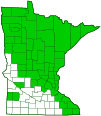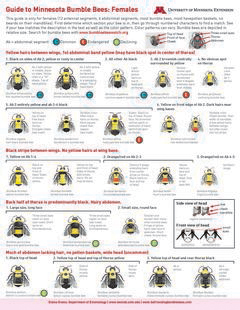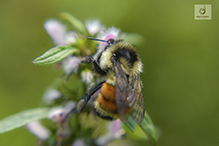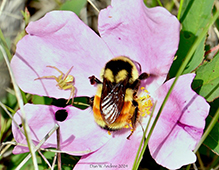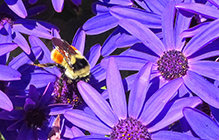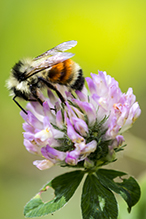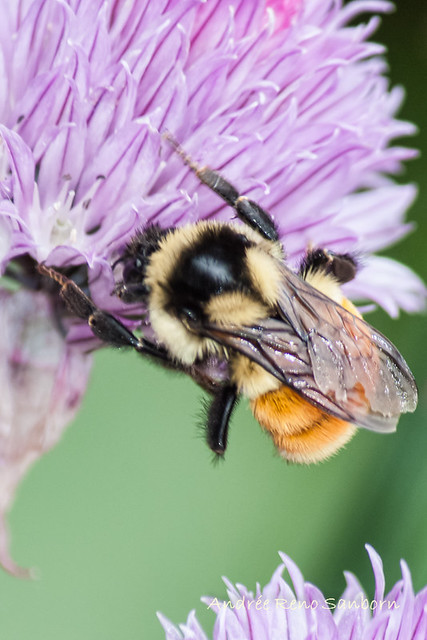tricolored bumble bee
(Bombus ternarius)
Conservation • Description • Habitat • Ecology • Distribution • Taxonomy
|
|
||||||||||||||
Description |
Tricolored bumble bee is a common, small, colonial, ground-nesting bumble bee. The female (worker) bee is 5 ⁄16″ to ½″ long. The thorax and abdomen are densely covered with short hairs. The thorax is mostly yellow with a conspicuous black T-shaped mark. There are six abdominal segments. The first and fourth abdominal segments are yellow, the second and third are orange, and the fifth and sixth are black. The head is black with a few yellow hairs, especially around the base of the antennae. The tongue is short. The queen is similar but longer and plumper. The male (drone) is similar but has longer hairs, a yellow head with a few black hairs, and yellow on the sides of the fifth and sixth abdominal segments. |
Size |
Queen: ⅝″ to ¾″ Male: ⅜″ to ½″ Worker: 5 ⁄16″ to ½″ |
Similar Species |
Red-belted bumble bee (Bombus rufocinctus) has a black dot, not a T-shaped mark, on the thorax. |
Habitat |
Various |
Ecology |
Season |
May to October |
Behavior |
Bumble bees will sting to protect themselves or their nest. The stinger is not barbed and the bee can sting multiple times. |
Life Cycle |
In April the queen emerges from hibernation and searches for a new nesting site. A suitable site is typically a small rodent burrow or a natural crevice in the ground. After locating a site the queen will forage for pollen and nectar to feed her future offspring. She then lines the nest with a waxy substance that she secretes, lays eggs fertilized in the previous season, and incubates the eggs. After the eggs hatch the newly emerged larvae, all female workers, pass through three stages before pupating and finally emerging as adults. The workers assist in expanding the nest, foraging for food, and incubating the eggs. The queen continues laying fertilized eggs throughout the summer. In late summer she begins laying unfertilized eggs which will develop into drones. In early fall the queen lays the last of her fertilized eggs. These develop into queens. The new queens forage for food, build up body fat, and mate with drones. In mid-fall the old queen and the rest of the colony dies, leaving only the new queens. The queens overwinter individually under a few inches of loose soil or leaf litter. |
Larva Food |
Larvae are fed both nectar for carbohydrates and pollen for protein. |
Adult Food |
Adults feed mostly on nectar but also on some pollen, especially flowers of blackberries, raspberries, goldenrods, blueberries, bilberries, and milkweeds. |
Distribution |
||
|
Sources |
|
| 5/4/2024 | ||
Occurrence |
||
Common in northern Minnesota |
||
Taxonomy |
|
Order |
Hymenoptera (Ants, Bees, Wasps, and Sawflies) |
Suborder |
Apocrita (Narrow-waisted Wasps, Ants, and Bees) |
Infraorder |
Aculeata (Ants, Bees, and Stinging Wasps) |
Superfamily |
Apoidea (Bees and Apoid Wasps) |
Epifamily |
|
Family |
Apidae (honey bees, bumble bees, and allies) |
Subfamily |
Apinae (honey, bumble, longhorn, orchid, and digger bees) |
Tribe |
Bombini (bumble bees) |
Genus |
|
Subgenus |
Pyrobombus |
In the not-too-distant past, bumble bees were often placed in the in the subfamily Bombinae, and sometimes in the family Bombidae. Today, both of these terms are considered taxonomically invalid, though they can still be found in use on the Web. |
|
Subordinate Taxa |
|
|
|
Synonyms |
|
|
|
Common Names |
|
orange-belted bumble bee tricolored bumble bee tricolored bumblebee |
|
Minnesota Bumble Bee Identification Guide
The University of MN Bee Lab has a free field identification guide to Minnesota bumble bees. It is indispensable for amateur naturalists or anyone wanting to identify the bumble bee in their photo. Click on the image below to download the guide.
Visitor Photos |
||
Share your photo of this insect. |
||
This button not working for you? |
||
Mike Poeppe |
||
 |
 |
|
 |
||
|
||
I found the bee tonight a mile west of Houston. |
||
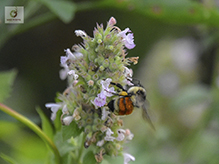 |
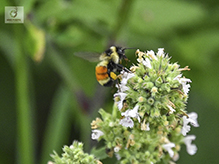 |
|
I did get a few close pictures of this bee and I am unsure what it is? I do know that it does stand out! |
||
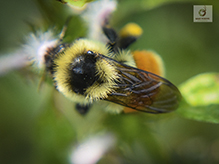 |
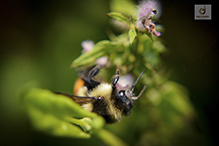 |
|
|
||
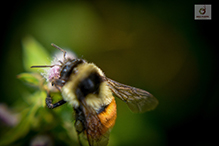 |
||
Dan W. Andree |
||
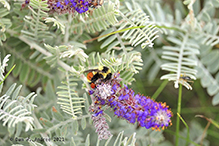 |
||
a nice colored bumble bee |
||
Bumble Bee & Northern Crab Spider... The bumble bee landed on the wild rose blossom and moved around while it fed and the crab spider got spooked and moved away from the bee. |
||
Bobbi Johnson |
||
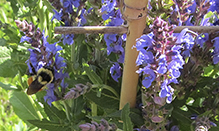 |
||
The little guy kept visiting my flowers today |
||
Ian Nicholson |
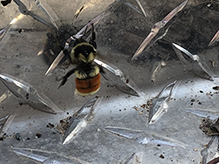 |
Bombus trenarius did not like its reflection in steel decking. April 27, 2020. |
Luciearl |
||
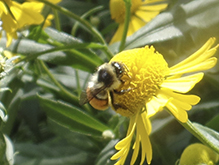 |
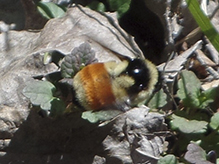 |
|
| Tricolored bumblebee on sneezeweed | They are loving the Creeping Charlie. One of the few flowers growing in abundance. |
|
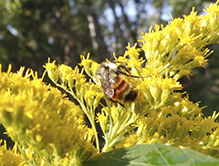 |
||
I haven't seen one since 2018, but still have this large goldenrod patch. |
||
… bumbles are preferring Goldenrod over coneflowers. At the bee fest. |
||
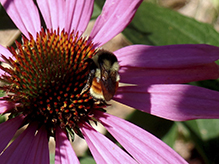 |
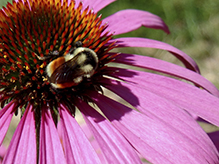 |
|
Barney |
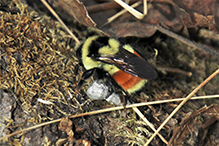 |
out walking looking for may flowers and heard this bumble and managed to get pic. Was on 5/5/2020 first bee here for the season. |
Bill Reynolds |
||
Was at the Old Treaty Crossing Festival Huot MN today. Came across a large patch of Cut-Leaf Coneflower which all abuzz with Honey Bees and Tricolored Bumble Bees. |
||
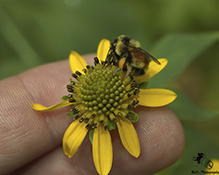 |
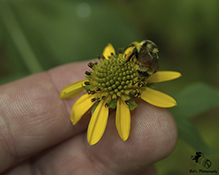 |
|
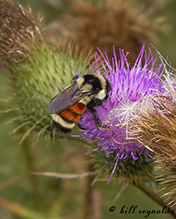 |
||
There is a pretty good sized Bull Thistle patch near where I live that the bees and butterflies are working pretty hard. |
||
There were quite a few Tri-colored Bumbles working the Tansy patch. |
||
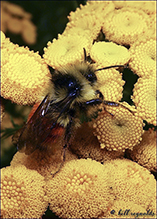 |
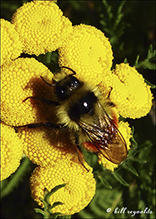 |
|
Crystal Boyd |
 |
Queen |
MinnesotaSeasons.com Photos |
||

Visitor Videos |
||
Share your video of this insect. |
||
This button not working for you? |
||
|
Other Videos |
||
Bombus ternarius - Tricolored Bumble Bee |
About
Published on May 15, 2012 No description available. |
Tricolored Bumble Bee (Apidae: Bombus ternarius) Queen |
About
Uploaded on May 6, 2011 Hooray! Fertile Queen Bumble Bees finally emerged from their long, long, long winter's nap this week! Photographed at Grand Forks, North Dakota (06 May 2011). |
Tricolored Bumble Bee (Apidae: Bombus ternarius) Worker on Leaf |
About
Uploaded on Aug 15, 2010 Photographed at Grand Forks, North Dakota (14 August 2010). |
Tricolored Bumble Bee (Apidae: Bombus ternarius) on Dandelion |
About
Uploaded on May 12, 2010 Photographed at Grand Forks, North Dakota (12 May 2010). |

Visitor Sightings |
||
Report a sighting of this insect. |
||
This button not working for you? |
||
Mike Poeppe |
Location: Houston, MN |
 |
| Dan W. Andree June 2024 |
Location: Frenchman’s Bluff SNA The bumble bee landed on the wild rose blossom and moved around while it fed and the crab spider got spooked and moved away from the bee. |
| Bobbi Johnson 5/3/2024 |
Location: Silver Bay, MN The little guy kept visiting my flowers today |
 |
| Mike Poeppe 7/31/2021 |
Location: Houston County, MN I did get a few close pictures of this bee and I am unsure what it is? I do know that it does stand out! |
| Mike Poeppe 7/30/2021 |
Location: Houston County, MN I found the bee tonight a mile west of Houston. |
| Bobbi Johnson 7/10/2021 |
Location: Silver Bay, MN |
| Dan W. Andree 7/6/2020 |
Location: Frenchman’s Bluff SNA a nice colored bumble bee |
| Luciearl 9/3/2020 |
Location: Cass County Tricolored bumblebee on sneezeweed |
| Luciearl 5/20/2020 |
Location: Cass County They are loving the Creeping Charlie. One of the few flowers growing in abundance. |
| Barney 5/5/2020 |
Location: north of Virginia, MN out walking looking for may flowers and heard this bumble and managed to get pic. Was on 5/5/2020 first bee here for the season. |
| Ian Nicholson 4/27/2020 |
Location: Winona County, Winona City Bombus trenarius did not like its reflection in steel decking. April 27, 2020. |
| Luciearl Summer 2018 |
Location: Cass County I haven't seen one since 2018, but still have this large goldenrod patch. |
| Luciearl 8/3/2018 |
Location: Lake Shore, MN … bumbles are preferring Goldenrod over coneflowers. At the bee fest. |
| Bill Reynolds 8/26/2017 |
Location: Red Lake Co MN Was at the Old Treaty Crossing Festival Huot MN today. Came across a large patch of Cut-Leaf Coneflower which all abuzz with Honey Bees and Tricolored Bumble Bees. |
| Suzy 7/17/2017 |
Location: Tabernash, CO Collecting pollen on grass weed seed. |
|
| Bill Reynolds 9/5/2015 |
Location: Pennington Co. There is a pretty good sized Bull Thistle patch near where I live that the bees and butterflies are working pretty hard. |
| Bill Reynolds 8/5/2003 |
Location: St Louis Co MN There were quite a few Tri-colored Bumbles working the Tansy patch. |
| Bill Reynolds 8/4/2003 |
Location: St Louis Co MN There were quite a few Tri-colored Bumbles working the Tansy patch. |
| Crystal Boyd 5/29/2013 |
Location: La Salle Lake SNA |
MinnesotaSeasons.com Sightings |
||

Created 1/27/2014 Last Updated: © MinnesotaSeasons.com. All rights reserved. |
